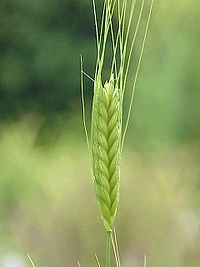
Photo from wikipedia
BackgroundWheat (Triticum aestivum L.) is one of the world’s most important grain crops. The amyloplast, a specialized organelle, is the major site for starch synthesis and storage in wheat grain.… Click to show full abstract
BackgroundWheat (Triticum aestivum L.) is one of the world’s most important grain crops. The amyloplast, a specialized organelle, is the major site for starch synthesis and storage in wheat grain. Understanding the metabolism in amyloplast during grain development in wheat cultivars with different quality traits will provide useful information for potential yield and quality improvement.ResultsTwo wheat cultivars, ZM366 and YM49–198 that differ in kernel hardness and starch characteristics, were used to examine the metabolic changes in amyloplasts at 10 and 15 days after anthesis (DAA) using label-free-based proteome analysis. We identified 523 differentially expressed proteins (DEPs) between 10 DAA and 15 DAA, and 229 DEPs between ZM366 and YM49–198. These DEPs mainly participate in eight biochemical processes: carbohydrate metabolism, nitrogen metabolism, stress/defense, transport, energetics-related, signal transduction, protein synthesis/assembly/degradation, and nucleic acid-related processes. Among these proteins, the DEPs showing higher expression levels at 10 DAA are mainly involved in carbohydrate metabolism, stress/defense, and nucleic acid related processes, whereas DEPs with higher expression levels at 15 DAA are mainly carbohydrate metabolism, energetics-related, and transport-related proteins. Among the DEPs between the two cultivars, ZM366 had more up-regulated proteins than YM49–198, and these are mainly involved in carbohydrate metabolism, nucleic acid-related processes, and transport.ConclusionsThe results of our study indicate that wheat grain amyloplast has the broad metabolic capability. The DEPs involved in carbohydrate metabolism, nucleic acids, stress/defense, and transport processes, with grain development and cultivar differences, are possibly responsible for different grain characteristics, especially with respect to yield and quality-related traits.
Journal Title: BMC Genomics
Year Published: 2018
Link to full text (if available)
Share on Social Media: Sign Up to like & get
recommendations!